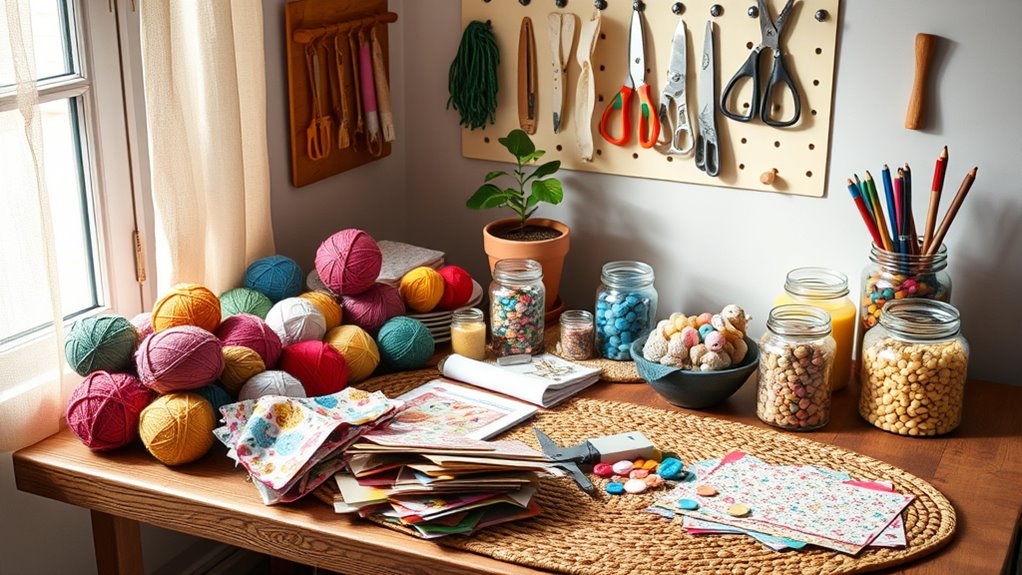To set up a craft club at home, create a dedicated, well-lit space with a large work surface and comfortable seating. Gather versatile supplies like scissors, glue, markers, paper, fabric, and embellishments, keeping everything organized in bins or drawers. Use affordable materials that suit multiple projects, such as acrylic paints and adhesive options. Keep the environment fun, accessible, and clutter-free. Want tips on streamlining your supplies and making setup easy? Keep exploring for more ideas.
Key Takeaways
- Dedicate a spacious, well-lit work area with organized storage for easy access to supplies.
- Gather versatile, cost-effective materials like paper, fabric, paints, and adhesives suitable for various crafts.
- Use simple tools such as scissors, glue, markers, and decorative embellishments to enhance creativity.
- Encourage participants to bring personal supplies and ideas to foster collaboration and personalization.
- Create themed or scheduled craft sessions to keep the environment engaging and maintain a fun, relaxing atmosphere.

Starting a craft club at home is a great way to enjoy creative activities with friends or family while making the most of your space. It’s simple to set up, doesn’t require a lot of fancy equipment, and can be tailored to any skill level or interest. The key to a successful craft club lies in having the right supplies on hand and creating an inviting, organized space where everyone feels comfortable. You don’t need to be a professional artist or crafter — just a little planning and enthusiasm will do.
Begin by gathering basic supplies that suit the types of crafts you want to do. For most projects, you’ll want a sturdy work surface, such as a large table or craft desk, along with comfortable seating. Stock up on essential tools like scissors, glue, paintbrushes, and markers. Keep an assortment of paper, cardstock, and different kinds of fabric or yarn handy, depending on your craft focus. It’s smart to have storage options such as bins or drawers to keep everything organized and easily accessible, preventing clutter from taking over your space.
To keep things simple and cost-effective, consider using versatile supplies that can be adapted for multiple projects. For instance, a set of acrylic paints can be used for decorating paper, fabric, or wood. Similarly, a good pair of scissors and a variety of adhesives, like glue sticks and craft glue, are indispensable. If you’re doing jewelry or small decorative items, having pliers and bead organizers helps keep things tidy. For seasonal or themed projects, add some decorative embellishments like stickers, washi tape, or glitter. These small touches can elevate simple crafts and make the experience more fun.
Setting up your space is just as important as stocking your supplies. Clear a dedicated area where everyone can spread out their work without feeling cramped. Use good lighting—natural light is best, but adjustable lamps work well too. Keep your supplies within easy reach but organized, so the table doesn’t turn into a mess. If you plan to do multiple sessions, consider creating a rotating schedule or themed craft days to keep everyone engaged and excited. Additionally, incorporating organizational tips from home improvement strategies can help maximize your storage and workspace efficiency.
Finally, encourage everyone to bring their own ideas and favorite materials, fostering a collaborative spirit. Keep supplies affordable and accessible, so participation stays high. Remember, the goal isn’t perfection but creativity and shared enjoyment. With a well-stocked supply list and a welcoming setup, your craft club at home can become a treasured weekly retreat, where friends and family gather to create, share, and have fun.
Frequently Asked Questions
How Can I Adapt Crafts for Different Age Groups at Home?
You can adapt crafts for different age groups by adjusting the complexity of the projects and materials used. For younger children, choose simple, safe supplies like glue, paper, and stickers, focusing on fun and creativity. For older kids, introduce more detailed techniques like painting or sewing. Always supervise and provide clear instructions, ensuring each activity matches their skill level to keep everyone engaged and safe.
What Safety Precautions Should I Take During Craft Activities?
Always prioritize safety during craft activities by preparing protective gear, such as gloves and goggles, especially when handling sharp tools or hot glue. Keep a clean, clutter-free workspace to prevent accidents. Supervise young children closely, offering assistance and ensuring they use materials properly. Store hazardous supplies out of reach, and teach safe handling practices. This proactive approach promotes a safe, satisfying, and successful crafting session for everyone involved.
How Do I Organize Supplies to Keep My Space Tidy?
You should organize your supplies by using clear bins or containers for different craft materials, labeling each one for easy access. Keep frequently used items nearby, and store less-used supplies separately. Use a designated workspace to contain clutter, and regularly tidy up to prevent messes. Installing shelves or pegboards helps keep tools visible and accessible. This setup keeps your space neat, making craft time more enjoyable and efficient.
Can I Involve Pets in Craft Activities Safely?
You can definitely involve your pets in craft activities safely, like adding a splash of color to your day. Keep small supplies out of paws’ reach to prevent messes or choking hazards, and choose pet-friendly materials like soft fabrics or non-toxic paints. Supervise closely, and create designated pet-safe areas. This way, your furry friends become part of the fun without risking their safety or your craft supplies.
What Are Some Eco-Friendly Craft Supply Alternatives?
You can use eco-friendly craft supplies like recycled paper, biodegradable glues, and natural fibers such as jute or hemp. Opt for beeswax wraps instead of plastic wrap, and choose non-toxic paints and markers. Consider repurposing old fabric scraps for sewing projects or using cardboard boxes for building. By selecting sustainable materials, you reduce waste and minimize environmental impact, making your craft activities more eco-conscious and enjoyable.
Conclusion
Starting craft clubs at home is simple, fun, and rewarding. With the right supplies, easy setups, and a little creativity, you create a space for connection, learning, and joy. Embrace the process, enjoy the mess, and celebrate each finished project. Whether you’re crafting alone or with friends, remember that the most important thing is to have fun, stay inspired, and keep creating. So gather your supplies, set your space, and let the crafting begin!









